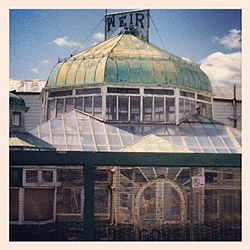
Green-Wood Cemetery is a 478-acre (193 ha) cemetery in the western portion of Brooklyn, New York City. The cemetery is located between South Slope/Greenwood Heights, Park Slope, Windsor Terrace, Borough Park, Kensington, and Sunset Park, and lies several blocks southwest of Prospect Park. Its boundaries include, among other streets, 20th Street to the northeast, Fifth Avenue to the northwest, 36th and 37th Streets to the southwest, Fort Hamilton Parkway to the south, and McDonald Avenue to the east.

Kings County Savings Bank is a former bank building at 135 Broadway in the Williamsburg neighborhood of Brooklyn in New York City. It is an example of French Second Empire-style architecture. Construction of the building began in 1860, to designs of William H. Willcox of Brooklyn, in partnership with prominent New York architect Gamaliel King, working as King & Willcox. The structure was continuously occupied by banks until the 1990s. The Williamsburg Art & Historical Center has operated the building since 1996.

This list is intended to be a complete compilation of properties and districts listed on the National Register of Historic Places in Rensselaer County, New York, United States. Seven of the properties are further designated National Historic Landmarks.
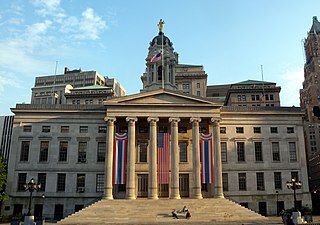
Brooklyn Borough Hall is a building in Downtown Brooklyn, New York City. It was designed by architects Calvin Pollard and Gamaliel King in the Greek Revival style, and constructed of Tuckahoe marble under the supervision of superintendent Stephen Haynes.
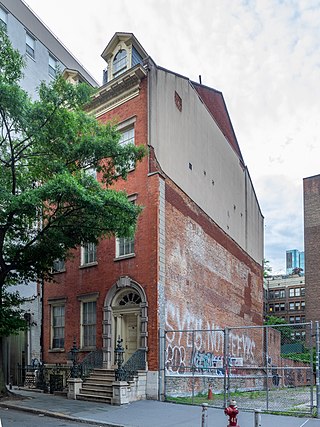
The Merchant's House Museum, known formerly as the Old Merchant's House and as the Seabury Tredwell House, is the only nineteenth-century family home in New York City preserved intact—both inside and out. Built "on speculation" in 1832 by Joseph Brewster, a hatter by trade, it is located at 29 East Fourth Street, between Lafayette Street and the Bowery in Manhattan. It became a museum in 1936, founded by George Chapman, a cousin of the family who once lived there.

Gage and Tollner is a restaurant on 372 Fulton Street in the Downtown Brooklyn neighborhood of New York City. It had been in business since 1879 and in the same location since 1892 until it closed on February 14, 2004. The restaurant reopened in April 2021.

Greenwood Heights is a neighborhood in the New York City borough of Brooklyn, named partially after the adjacent Green-Wood Cemetery. Greenwood Heights is a part of Brooklyn Community District 7 along with Windsor Terrace, Sunset Park and South Slope. The much-debated borders are roughly the Prospect Expressway to the north, Gowanus Canal and Upper New York Bay to the west, Eighth Avenue to the east, and 39th Street to the south.

The Octagon, built in 1834, is a historic octagonal building and attached apartment block complex located at 888 Main Street on Roosevelt Island in New York City. It originally served as the main entrance to the New York City Mental Health Hospital, which opened in 1841. Designed by Alexander Jackson Davis, the five-story rotunda was made of blue-gray stone that was quarried on the island. The Octagon is the last remnant of the hospital, and after many years of decay and two fires, was close to ruin. After restoration, it has now been incorporated into the adjacent buildings to create a large apartment complex.
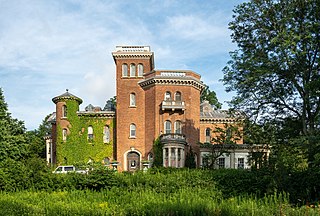
Litchfield Villa, or "Grace Hill", is an Italianate mansion built in 1854–1857 on a large private estate now located in Prospect Park, Brooklyn, New York City. It is located on Prospect Park West at 5th Street. The villa was designed by Alexander Jackson Davis, America's leading architect of the fashionable Italianate style, for railroad and real estate developer Edwin Clark Litchfield.
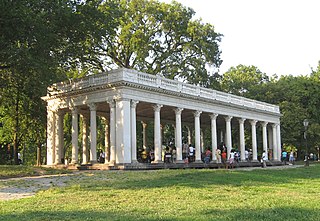
The Grecian Shelter, designated a Croquet Shelter on the original plans of Prospect Park, is also referred to as the Prospect Park Peristyle or Peristyle. The building, a peristyle with Corinthian columns, is situated near the southern edge of Prospect Park in Brooklyn, New York. Constructed by McKim, Mead and White in 1905, this peristyle was built on the site of the 1860s-era Promenade Drive Shelter along the southwest shore of the Prospect Park Lake. The Prospect Park Peristyle is designed in the Renaissance architectural style. It consists of a raised platform located two steps above ground level; the platform is covered by a rectangular colonnade with 28 Corinthian marble columns, each with square piers. An entablature of terracotta runs atop the structure. The building was constructed as a temporary refuge from rain and sun.
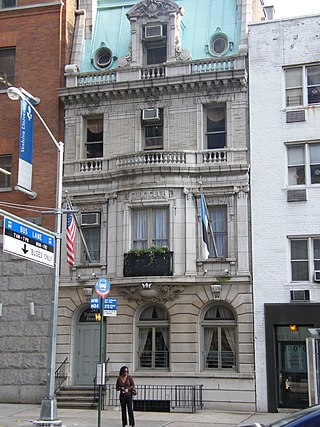
The Civic Club building, now the New York Estonian House, is a four-story Beaux-Arts building located at 243 East 34th Street between Second and Third Avenues in the Murray Hill neighborhood of Manhattan in New York City.
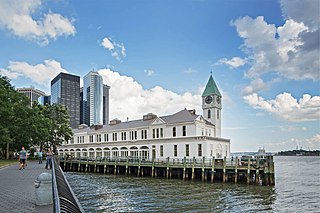
The New York Landmarks Conservancy is a non-profit organization "dedicated to preserving, revitalizing, and reusing" historic structures in New York state. It provides technical assistance, project management services, grants, and loans, to owners of historic properties. Since its founding, the conservancy has provided more than $40 million in grants and loans.

The Federal Building and Post Office is a historic main post office, courthouse, and Federal office building in Brooklyn, New York. The original building was the Brooklyn General Post Office, and is now the Downtown Brooklyn Station, and the north addition is the courthouse for the United States Bankruptcy Court for the Eastern District of New York, and is across the street from and in the jurisdiction of the main courthouse of the United States District Court for the Eastern District of New York, the Theodore Roosevelt Federal Courthouse. It also houses offices for the United States Attorney, In 2009, the United States Congress enacted legislation renaming the building the Conrad B. Duberstein United States Bankruptcy Courthouse, in honor of chief bankruptcy judge Conrad B. Duberstein.

The Friends Meetinghouse and School is an historic Quaker meeting house and adjacent school building at the corner of Schermerhorn Street and Boerum Place in the Boerum Hill neighborhood of Brooklyn, New York City.
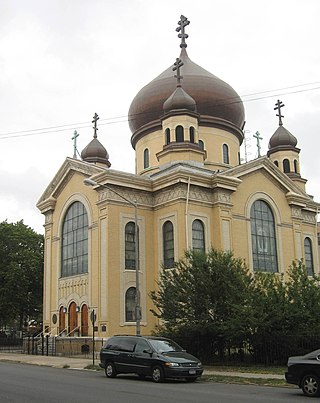
Russian Orthodox Cathedral of the Transfiguration of Our Lord is a historic Russian Orthodox cathedral at 228 North 12th Street in the Williamsburg neighborhood of Brooklyn, New York City. The cathedral was designated a New York City landmark by the Landmarks Preservation Commission in 1969, and was listed on the National Register of Historic Places in 1980.
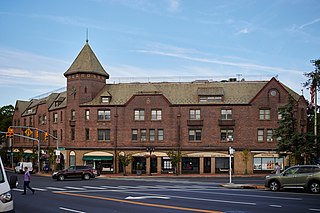
Grace and Thomaston Buildings are two historic commercial buildings located at Great Neck Plaza in Nassau County, New York. The Grace Building was built in 1914 and the Thomaston Building in 1926. They were both built by the W. R. Grace and Company.

Prospect Cemetery is a historic cemetery located in the Jamaica section of the New York City borough of Queens. It was established in 1668 and known as the "burring plas." The cemetery's original main gate was on Beaver Road which led from Sutphin Boulevard to Jamaica Avenue. The cemetery was generally known as the Presbyterian burial ground and is one of the few remaining Colonial cemeteries in Queens.
This is a timeline and chronology of the history of Brooklyn, New York. Brooklyn is the most populous of New York City's boroughs, and was settled in 1646.
